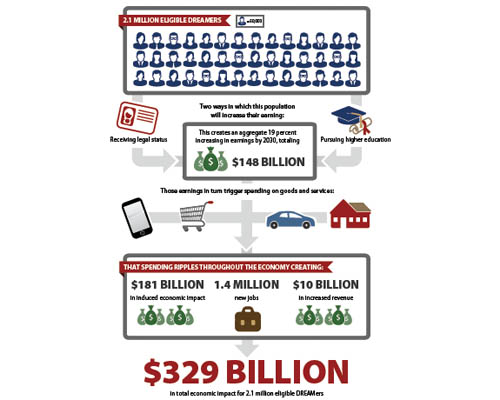 What would happen if the United States were to grant a pathway to legal status to an estimated 2.1 million eligible youth in our country by passing the DREAM Act?
What would happen if the United States were to grant a pathway to legal status to an estimated 2.1 million eligible youth in our country by passing the DREAM Act?
That’s the focus of a new report released by the Center for American Progress and Partnership for a New American Economy. The report reveals that the DREAM Act, with its many benefits, would – “most importantly” – provide a significant boost to the economy. Among the findings, the report notes that passage of the DREAM Act would add $329 billion to the U.S. economy and create 1.4 million new jobs by 2030, thus “demonstrating the potential of the proposed law to boost economic growth and improve our nation’s fiscal health.”
More:
We find in this report that enabling these 2.1 million eager-to-be-Americans to contribute to building the American Dream would deliver a double boost to our economy. First, enacting the law would provide an incentive for their further education because for most of those who would be eligible the legalization provisions can only be attained through completion of high school and some college. Receiving more education opens access to higher-paying jobs, enabling these undocumented youth to become much more productive members of our society. Second, gaining legal status itself translates into higher earnings for these youth since legal status allows DREAMers to apply to a broader range of high-paying jobs rather than having to resort to low-wage jobs from employers who are willing to pay them under the table.
Thus our projections track both the gap in current earnings between unauthorized individuals at various levels of education and their U.S.-born counterparts, as well as the gains in earnings from attaining more education. Overall, our research finds that by 2030 the eligible DREAMer population will earn 19 percent more in earnings than without passage of the DREAM Act, in turn increasing their consumption and contributing more in the way of tax revenue to the federal government.
Hungry for more? Below, you’ll find links to the actual report. For those of you who are more visual thinkers, check out this nifty infographic.

